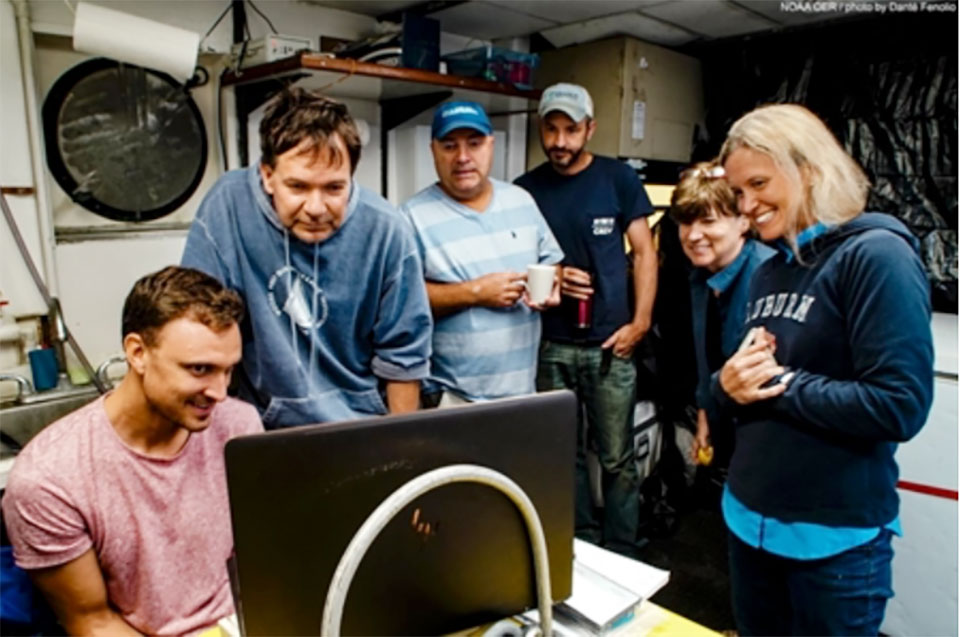NOAA-FUNDED EXPEDITION CAPTURES RARE FOOTAGE OF GIANT SQUID IN THE GULF OF MEXICO
This Is The Second Time A Giant Squid Has Been Captured On Camera In Its Deepwater Habitat
It’s what every marine scientist hopes for when they journey into the ocean’s depths. So when Nathan Robinson, one of the scientists on a NOAA-funded expedition to the deep waters of the Gulf of Mexico, saw that first glimpse of a tentacle rise out of the inky black of his computer screen, he was captivated.
“You feel very alive,” he said of the footage, which showed a giant squid in its natural habitat for just the second time in history. “There’s something instinctual about these animals that captures the imagination of everyone — the wonder that there are these huge animals out there on our planet that we know so little about, and that we’ve only caught on camera a couple of times.”
The squid was captured by the Journey into Midnight expedition at a depth of 759 meters (2,490 feet) and looked to be 10 – 12 feet long. The scientists on the ship sent the footage to Michael Vecchione, a NOAA Fisheries zoologist and expert in all things octopus and squid, to see if he could identify the creature. Vecchione confirmed that he was nearly certain that this was a squid of the genus Architeuthis — a giant squid. “Giant squid” is a term that’s sometimes used to describe a range of larger squid specimens, but scientifically, Vecchione said only squids of the genus Architeuthis can be considered giant squid.
“The benchmark is taxonomy, rather than size — it’s either genetically a giant squid or not,” said Vecchione, who works at NOAA Fisheries National Systematics Lab at the Smithsonian Museum of Natural History. “People will refer to other things as giant squids, but cephalopod biologists don’t.”
The new footage was captured by the MEDUSA, a camera system that’s designed to give scientists a glimpse into the deep ocean without disturbing the light-sensitive creatures that live there. It uses red light, which many deep-dwelling creatures cannot see, as well as a lure modeled off of a bioluminescent jellyfish. The lure is meant to attract larger predators: Since some jellyfish create bioluminescent displays when attacked, some large predators in the deep ocean look out for this “burglar alarm” display, and show up to feed on whatever it is that’s disturbing the jellyfish. The MEDUSA first captured a giant squid on video in 2012 off the coast of Japan.
The two videos can teach scientists a lot about the giant squid. They were both captured at 2,490 feet below the surface, which means the squid lives in a world that’s very dimly lit. They show that giant squids are active creatures — they don’t float around and passively wait for food to drift by, which Vecchione said was a hypothesis at one time. They also have huge eyes — the largest eyes of any animal on the planet — and their attraction to the jellyfish lure means they’re visual predators.
“In the video, we could clearly see that it was visually tracking the electronic jellyfish, which was very exciting to be able to observe,” said Edie Widder, chief executive officer of the Ocean Research & Conservation Association and the developer of the MEDUSA technology.
All of this can be used in future studies about the animal.
“All by itself, it’s interesting,” Vecchione said of the video. “When you compile this plus other observations, that’s when you start seeing patterns, and when you are able to infer the life story for that species.”
It also points to the importance of this type of ocean exploration. More than 80 percent of the ocean remains unexplored, and scientists are working to build their knowledge of the vast array of species that live in the deep ocean. Giant squids aren’t uncommon creatures. They wash ashore fairly regularly off the coast of northern Spain, Vecchione said, because the noise involved in oil exploration there can be lethal to them. But viewing one in its natural habitat is rare, and is a testament to the contributions ocean exploration is making to the public understanding of the ocean.
“I think we often think of the deep sea as out of sight, out of mind,” said Sonke Johnsen, a biology professor at Duke University and the chief scientist aboard the expedition. But the location of the squid — which was captured on film just 100 miles southeast of New Orleans — shows that the deep waters in America’s backyard hold wonders.
“It’s not some exotic creature found thousands of miles away in some unknown deep. It’s our animal,” he said. “And I think that’s what we as explorers do — we point a finger down into the deep and say this is here, this is amazing and it’s beautiful and it’s something we should care about.”
For more information on NOAA’s role in ocean exploration — and to watch a live stream of an expedition going on from June 21 – July 11 — click here.
Left to right: Nathan Robinson, Sonke Johnsen, Tracey Sutton, Nick Allen, Edie Widder, and
Megan McCall gather around to watch the squid video. Image courtesy of Danté Fenolio.
